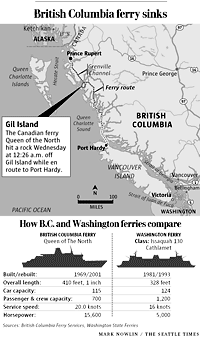"Terrible crunching noise" before B.C. ferry sank

PRINCE RUPERT, British Columbia — Just after midnight, the Queen of the North was pushing its way through the cold, dark waters of the Inside Passage when a massive jolt reverberated through the ship's aging hull, waking passengers who had retired for the night.
"We heard this terrible crunching noise," said 74-year-old Douglas Rice, who was asleep in his stateroom, beside his wife.
The ferry apparently had strayed from safe shipping lanes early Wednesday, officials said, and struck a rock, ripping open the 37-year-old ferry's hull.
The cold Pacific began pouring in at an unstoppable rate. The ship's alarms clanged. Its crew of 42 began running through the hallways, breathlessly ordering the 59 passengers to get topside, carrying out the disaster drill they hoped never, ever to actually use.
"You could feel the whole boat shake," said 34-year-old Kirby Jackson. "It was listing on one side."
After jumping into an inflatable dinghy with 20 other people, Jackson said he looked back and saw the bow of the ferry slide into the ocean.
"It looked just like the Titanic," he said. "You could hear this loud, sucking noise. ... I was terrified."
The 409-foot Queen of the North sank in about 1,100 feet of water near the remote Gil Island in B.C.'s Inside Passage. The area is about 80 miles south of Prince Rupert and about 580 miles northwest of Seattle.
The ferry served the 280-mile route between Prince Rupert and Port Hardy at the northern end of Vancouver Island. At the time of the accident, it was southbound on an overnight run.
There were no confirmed deaths but, by late Wednesday, two passengers were unaccounted-for. They are believed to have survived the sinking but could not be found in the final count of passengers.
The ferry sank in choppy seas, driving rain and high winds. It was not known whether mechanical failure or human error contributed to the accident. Investigators from Canada's federal Transportation Safety Board and BC Ferries scrambled to the scene to begin work.
The ship sent out a Mayday call at 12:26 a.m. and within a half-hour passengers and crew took to the life rafts.
"I was in my nightie and he was in his pajamas," said Rice's 69-year-old wife, Sylvia.
There was time only to pull on their overcoats before scrambling to the deck, which was now listing to one side and made treacherous by the heavy, wind-whipped rain that slicked the deck.
The sea was rough, and some of the lifeboats couldn't be lowered. The Rices, like the other passengers, were given regulation-red life jackets to pull over their overcoats.
"The water was so icy, you just know you're going to die if you get in the water," Sylvia Rice said.
For all those aboard, the question now was: Who would come to their rescue?
The first help to arrive was a group of fishing boats and speedboats from the nearby community of Hartley Bay.
Jessie Bolton said he learned of the sinking ship after 1 a.m. and raced to help in his 18-foot speedboat.
The lights of the ferry were still on when he reached the passengers in lifeboats and inflatable rafts, said Bolton, 21. He was helping five passengers into his boat when the ferry sank.
"The stern went down, then the bow went straight up out of the water. The whole thing stood straight up and went down," said Bolton.
Karen Clifton, the manager of the Hartley Bay cultural center, said the rescuers never flinched. "They're only doing what they always do in an emergency. It was chaotic, but things went well."
Eleven people were flown by helicopter to Prince Rupert for medical treatment — all were later released — and the rest were taken to Prince Rupert by Coast Guard vessels.
"Anytime you have a major incident and you have no one hurt or killed in this type of thing, I think you always think it's a miracle," said David Hahn, president of BC Ferries.
The shipwreck also set off calls for an inquiry into the design of the ferry, which was built with one large compartment. The Queen of the North was one of the fleet's older vessels and was being eyed for replacement because of a hull design that is considered less safe by modern shipbuilding standards. Newer ships that ply deep waters must be designed with multiple compartments so that if one floods, the others can be sealed off.
The provincial ferry was equipped with two lifeboats, 30 inflatable life rafts, three survival craft and one rescue boat. It can carry about 700 passengers and 115 vehicles.
Jackie Miller, president of the BC Ferry and Marine Workers Union, cautioned the public not to jump to the conclusion that the crew of the ship were at fault for the sinking, noting it might very well have been a mechanical problem.
Miller said the Queen of the North was built in the same German shipyard as the Herald of Free Enterprise, a British ferry that capsized off the Belgian port of Zeebrugge, killing close to 200 people in 1987. That ferry was swamped when its rear doors were left open.
"We know what happened to that ship," she said. "We've always had concerns about it."
The Queen of the North was thought to be carrying some 58,000 gallons of diesel fuel, prompting fears of an ecological disaster. The 16 vehicles on board also could be leaking gasoline. The B.C. Environment Ministry dispatched emergency crews to try to contain the spill.
By late Wednesday life jackets, cafeteria trays and paper floated in the spreading slick.
The Associated Press and Seattle Times staff reporter Jonathan Martin contributed to this report.

